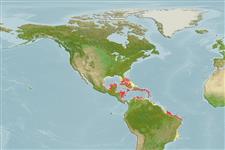Teleostei (teleosts) >
Perciformes/Serranoidei (Groupers) >
Serranidae (Sea basses: groupers and fairy basslets)
Etymology: Hypoplectrus: Greek, hypo = under + Greek, plektron = sting, spur (Ref. 45335).
More on author: Poey.
Environment: milieu / climate zone / depth range / distribution range
Ecology
Marine; reef-associated; depth range 3 - 30 m (Ref. 9710). Tropical
Western Central Atlantic: Jamaica, Cayman Islands, Florida (USA), Bahamas, Greater Antilles, Lesser Antilles and Honduras.
Size / Weight / Age
Maturity: Lm ? range ? - ? cm
Max length : 13.0 cm TL male/unsexed; (Ref. 9710)
Head yellow, body black to brown (extent of the yellow and black portions can vary). The yellow and black portions are divided by a diagonal line that extends from the nape posteriorly and ventrally to the anal fin. Face and all fins yellow. Pectoral fins pigmented. Head with iridescent blue lines (as in butter hamlet but the lines are fewer in number and more pronounced). Two black spots bordered by iridescent blue may be found on the snout in the region of the nares.
A solitary species (Ref. 26340) inhabiting rocky or coral reefs, often near staghorn coral (Ref. 9710). Travels in pairs and remains close to the bottom (Ref. 26938).
Life cycle and mating behavior
Maturities | Reproduction | Spawnings | Egg(s) | Fecundities | Larvae
Domeier, M.L., 1994. Speciation in the serranid fish Hypoplectrus. Bull. Mar. Sci. 54(1):103-141. (Ref. 26407)
IUCN Red List Status (Ref. 130435)
Threat to humans
Harmless
Human uses
Fisheries: commercial; aquarium: commercial
Tools
Special reports
Download XML
Internet sources
Estimates based on models
Preferred temperature (Ref.
123201): 26.6 - 28.2, mean 27.5 °C (based on 605 cells).
Phylogenetic diversity index (Ref.
82804): PD
50 = 0.5000 [Uniqueness, from 0.5 = low to 2.0 = high].
Bayesian length-weight: a=0.01778 (0.00680 - 0.04650), b=3.03 (2.80 - 3.26), in cm total length, based on LWR estimates for this (Sub)family-body shape (Ref.
93245).
Trophic level (Ref.
69278): 3.8 ±0.4 se; based on size and trophs of closest relatives
Resilience (Ref.
120179): High, minimum population doubling time less than 15 months (Preliminary K or Fecundity.).
Fishing Vulnerability (Ref.
59153): Low vulnerability (10 of 100).
Nutrients (Ref.
124155): Calcium = 85.4 [47.3, 169.6] mg/100g; Iron = 0.684 [0.364, 1.305] mg/100g; Protein = 18 [16, 20] %; Omega3 = 0.132 [0.077, 0.222] g/100g; Selenium = 25.3 [13.8, 51.5] μg/100g; VitaminA = 94 [25, 406] μg/100g; Zinc = 1.36 [0.86, 2.08] mg/100g (wet weight);
